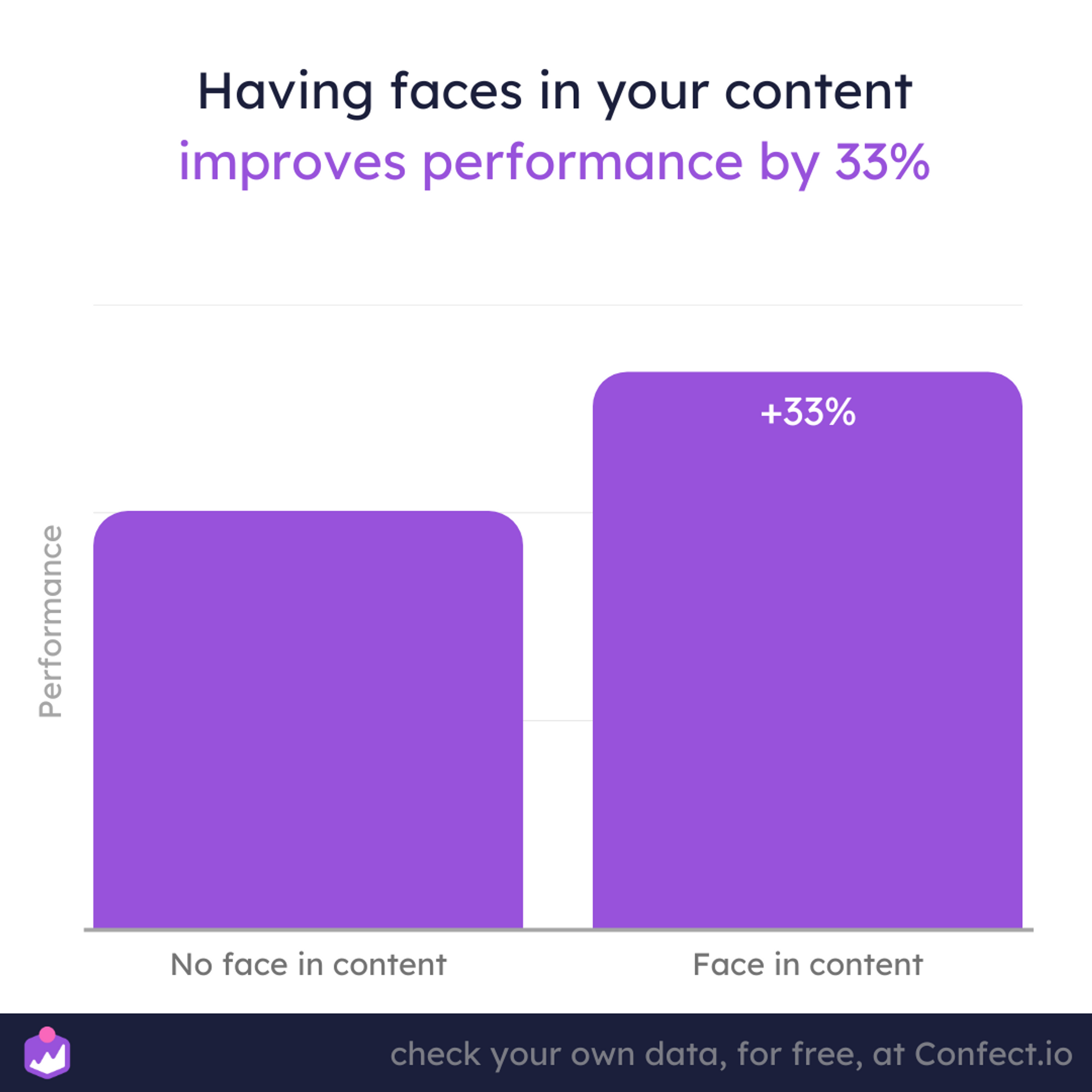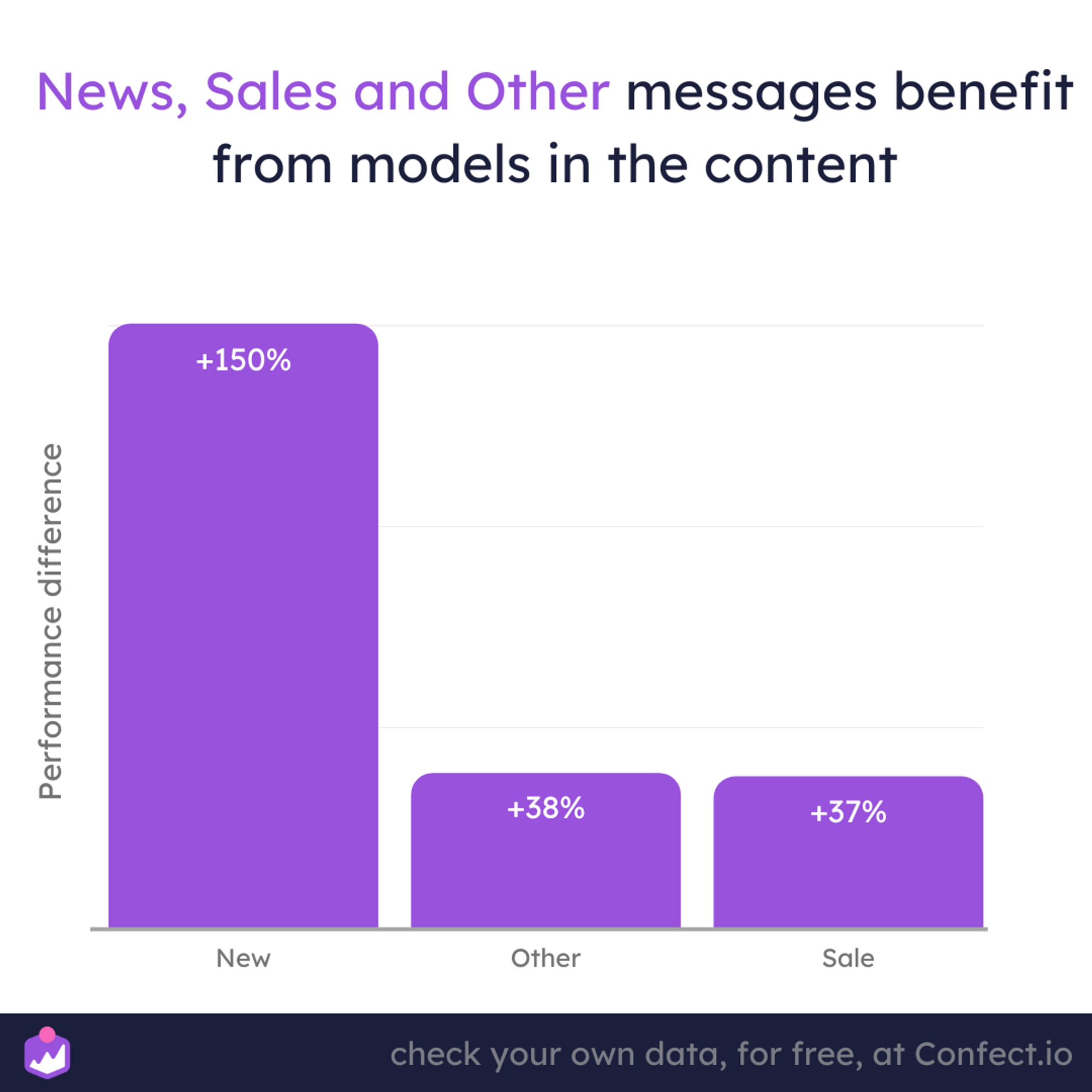How effective are models in fashion ads
August 9, 2022
There’s probably no other industry that uses as many models as the fashion industry.
From TV and magazines to Facebook ads, everything related to fashion usually has a model.
If so many fashion brands utilize models, something must be working.
After all, nobody wants to dish out the extra money to hire models if it's not going to result in a positive return on ad spend (ROAS).
But just how effective are ads showing models? And is it worth it? (models are expensive, right?!)
Below, we'll be taking a closer look at some data on the effectiveness of models in fashion ads.
But before we do, let's take a minute to explain why models can help boost ad performance.
Why do models make fashion ads more effective?
From a very young age, the human brain is wired to recognize faces.
After all, our parents' faces are some of the first things we notice as infants that become constants in our lives.
Then, we start noticing how those faces change, and we connect those changes with different feelings and emotions, AKA happy, sad, angry, etc.
Over time, our brains build recognition patterns that we end of using throughout the rest of our lives.
And it's those same pattern recognition skills that make human models and faces so effective in advertising.
Essentially, models and their faces are very easy to notice when we're scrolling through our social media feed.
And because it takes less time to process what a face is than it does to read a caption, having a model present really can be a thumb-stopper when it comes to your ads and getting people to notice them.
However, psychological pattern recognition isn't the only reason that models can make your ads more effective!
It's also the simple fact that, when you see a model wearing a hot outfit, it's easier for you to imagine yourself wearing that same outfit.
So models simply make fashion products feel more relatable to the audience!
Plus, models can prime the viewer's emotions as well!
For example, if a model looks happy while wearing an outfit, it can boost the product's likability since the viewer wants to feel that way too.
Ultimately, savvy fashion advertisers know that they can actually manipulate the audience's perception just by the faces and emotions displayed by models wearing their clothing.
All that said, I bet you're wondering just how much of a difference using models in your ads can make!
Well, let's find out!
Models in ads fashion ads work very well
In general, consumers who are into fashion want to see someone wear the clothes that they’re interested in.
And that's precisely why you always see outfits placed on mannequins in retail stores.
As we've already mentioned, seeing a model wearing a product just gives the consumer an idea of how the clothing would look on them.
This is why models work so well in fashion ads and on average the performance of the ads improves by 33%.

Read about why models improve performance.
However, not all fashion ads are created equal.
So just because you include a model in your fashion ad, it doesn't necessarily mean that you'll get the same results.
But the one thing we CAN tell you is that models SHOULD improve the performance of your fashion ads because it makes it easier for people to see what your products look like on a real person.
On another note, what your ad messaging says can impact how models affect their performance, but we'll get to different message types in a moment.
Models boost performance for NEW products by 150%
In general, no matter what category your ad messaging falls under, using models increases performance, especially when talking about fashion products.
However, fashion ads that talk about “new” (new products, new collections, etc.) see the highest performance increases using models.
In fact, we've found that including a model in an ad for new products or collections can boost ad performance by as much as 150%!
Note, however, that this insight is for "new" ads across all industries, and not just for fashion ads.
Still, it's an important insight proving that models DO help improve performance.

Again, the thought is that having a model use the new product lets consumers see how the clothes fit, how the colors look on a human, and so on.
So what about fashion ads specifically?
Models help fashion ads about new products and shipping the MOST!
We've found that fashion ads about “new” with a model gives you double the number of purchases per impression compared to not having a model.
Specifically, new product fashion ads with models perform as much as 109% better than other ads!
.png)
Similarly, models can also be very effective when used in ads about shipping.
Including a model in a fashion ad about shipping has been proven to boost performance by as much as 69%!
Essentially, when a model is shown wearing the product, it allows customers to see how the clothing looks.
But coupling this with shipping information, such as an offer for free returns makes the ad even more effective, as it allows the customer to try the product for themselves and return it if they are not satisfied.
It's basically like saying: "Try our outfits at NO RISK to you!"
Models won't always boost ad performance
Now, a word of warning!
These insights have been specific to fashion ads.
But we've actually found some contradicting data about models in ads with shipping, competitions, and free message types.
When we talk about ads across all industries, and not fashion, including models for ads about competitions, shipping, or ads about free stuff can actually harm your ad performance.
In fact, if your ad has a "free" message to it, including a model can actually lead to 60% worse performance!
Similarly, for shipping and free ad messages, including a model can lower performance, albeit not by quite as much.
-1.png)
So overall, yes, it's true that models can boost the performance of your ads.
But there are certain circumstances when using models should be avoided.
For instance, if you want to advertise your fashion products, and have a "free" product offering to go with them, you might not want to use a model in your ad.
As always, we recommend using these insights to inspire your ad ideas.
But don't forget to A/B test your creatives to find out what truly resonates most with your target audience.
Keep using models in your fashion ads
After looking at the data, it’s no surprise why models are used in fashion ads so frequently.
Let's recap some of the information we've learned today!
Models in fashion ads, on average, boosts performance by 33%.
Across all industries, including a model in an ad for new products or collections can boost ad performance by as much as 150%!
New product fashion ads with models perform as much as 109% better.
Fashion ads about shipping with models performance by as much as 69%!
Still, models and their faces are effective advertising tools because they are so easy to recognize and notice in a sea of information.
Models make fashion products more relatable. When you see a model wearing a hot outfit, it's easier for you to imagine yourself wearing that same outfit.
Ultimately, using models can give your content a significant boost in performance. And this is true no matter what type of messaging your fashion ad has.
However, the biggest increase in performance is seen with new ads and shipping ads.
If you’re currently running fashion ads without models, it might be a good idea to start including them in your content.
We also suggest trying Confect to see how easy it is to design, edit, and customize your catalog ads to include all the relevant information necessary to land your business's next sale!
You might see some significant jumps in performance!
More to read
This article focuses on models in fashion content. Keep learning and optimizing with the following insights:
- How do logos impact performance for fashion ads
- Content learnings from top fashion brands
- Better performance by fixing ad bodies for fashion ads
- Shipping and Free returns for fashion ads
- Create better SALES ads for fashion
- Tips how to use text for fashion ads
- How can fashion brands sell New products more effectively
Dataset
The dataset from this article is based on 967m+ impressions and 9500+ pieces of individual content on Meta (Facebook) platforms from Fashion brands ONLY. It takes into account data from only brands within fashion industry in all countries, with the campaign objectives of conversions only. The period is from 01.09.2021 - 16.09.2022.
Numbers are looking at correlation only, not causation. Remember to check your own data: numbers for different brands, industries, and contexts will vary. If you were intrigued about a specific insight, you can go in-depth into the various dimensions and how data can be segmented in Confect, here.
